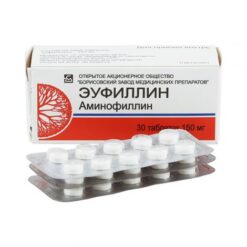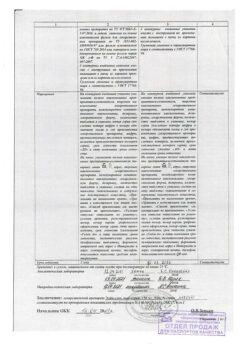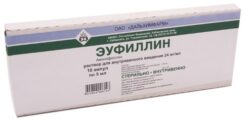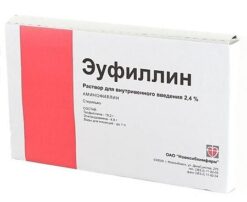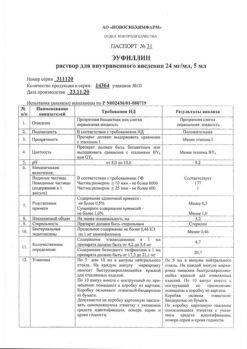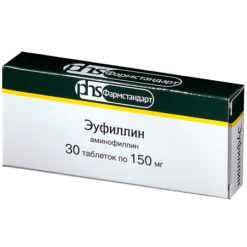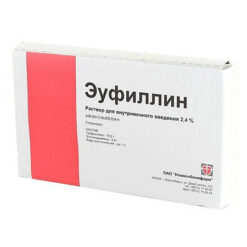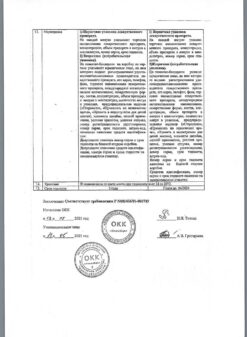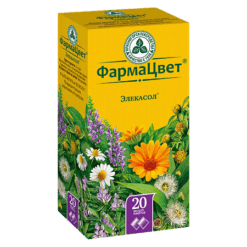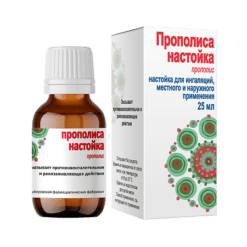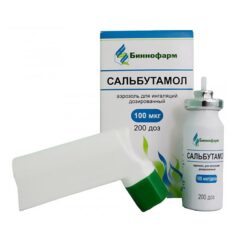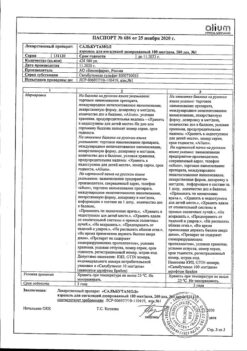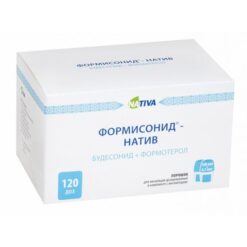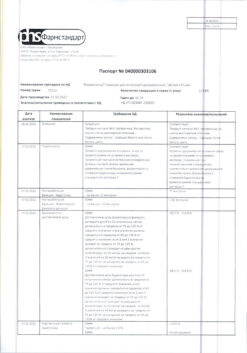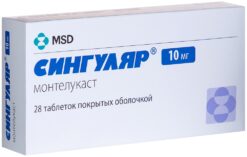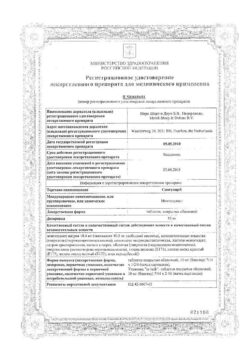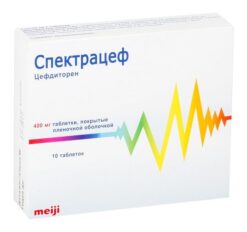No products in the cart.
Eufillin, tablets 150 mg, 30 pcs.
€1.00
Out of stock
(E-mail when Stock is available)
Description
Euphylline is a bronchodilator and an FDE inhibitor. It is ethylenediamine salt of theophylline (which facilitates solubility and increases absorption). It has a bronchodilator effect, apparently due to a direct relaxing effect on the smooth muscles of the airways and blood vessels of the lungs. It is believed that this effect is caused by selective inhibition of the activity of specific FDEs, which leads to an increase in the intracellular concentration of cAMP. The results of experimental studies in vitro show that the main role seems to be played by type III and type IV isoenzymes. Suppression of the activity of these isoenzymes may also cause some side effects of aminophylline (theophylline), including vomiting, arterial hypotension and tachycardia. It blocks adenosine (purine) receptors, which may be a factor of action on the bronchi.
It reduces airway hyperresponsiveness associated with the late phase of the response caused by inhaling allergens through an unknown mechanism that is not related to FDE inhibition or adenosine blockade. There are reports that aminophylline increases the number and activity of T-suppressors in peripheral blood.
Increases mucociliary clearance, stimulates diaphragm contraction, improves respiratory and intercostal muscle function, stimulates the respiratory center, increases its sensitivity to carbon dioxide and improves alveolar ventilation, which ultimately leads to a reduction in the severity and frequency of apnea episodes. By normalizing respiratory function, it promotes blood oxygenation and decreases carbon dioxide concentration. It enhances lung ventilation in conditions of hypokalemia.
It has a stimulating effect on heart activity, increases strength and heart rate, increases coronary blood flow and increases myocardial oxygen demand. Reduces the tone of blood vessels (mainly vessels of the brain, skin and kidneys). It has a peripheral venodilator effect, reduces pulmonary vascular resistance, lowers the pressure in the small circle of the circulation. Increases renal blood flow, has a moderate diuretic effect. Dilates extrahepatic biliary tracts. Stabilizes membranes of mast cells, inhibits release of mediators of allergic reactions. Inhibits platelet aggregation (inhibits platelet activation factor and PgE2α), increases resistance of red blood cells to deformation (improves rheological properties of blood), reduces thrombosis and normalizes microcirculation. It has a tocolytic effect and increases the acidity of gastric juice. In high doses it has epileptogenic effect.
Pharmacokinetics
In the body aminophylline is metabolized at physiological pH values with release of free theophylline. Bronchodilator properties are evident at plasma theophylline concentrations of 10-20 µg/ml. Concentrations above 20 mg/ml are toxic. The excitatory effect on the respiratory center is realized at lower concentrations of 5-10 µg/ml.
Theophylline’s binding to plasma proteins is approximately 40%; in newborns as well as in adults with disease, the binding decreases. Binding to plasma proteins is approximately 60% in adults, 36% in newborns, and 36% in cirrhotic patients. It penetrates the placental barrier (the concentration in the fetal serum is slightly higher than in the mother’s serum). It is excreted with the breast milk.
Theophylline is metabolized in the liver with the participation of several cytochrome P450 isoenzymes, the most important of which is CYP1A2. During metabolism 1,3-dimethylureic acid, 1-methylureic acid and 3-methylxanthine are formed. These metabolites are excreted in the urine. In adults, 10% is excreted unchanged. In infants, a significant portion is excreted as caffeine (due to the immaturity of its further metabolic pathways), unchanged – 50%.
Significant individual differences in the rate of hepatic metabolism of theophylline cause marked variability in values of clearance, plasma concentrations and elimination half-life. Such factors as age, smoking habits, diet, diseases, and concomitant drug therapy affect hepatic metabolism.
Theophylline’s T1/2 in non-smoking patients with bronchial asthma almost without pathological changes from other organs and systems is 6-12 hours, in smokers – 4-5 hours, in children – 1-5 hours, in newborns and premature infants – 10-45 hours.
T1/2 of theophylline is increased in elderly people and in patients with heart failure or liver diseases.
Clearance is decreased in heart failure, liver function disorders, chronic alcoholism, pulmonary edema, chronic obstructive pulmonary disease.
Ethylenediamine does not affect the pharmacokinetics of theophylline.
Indications
Indications
Active ingredient
Active ingredient
Composition
Composition
1 tablet contains:
the active ingredient:
aminophylline 150 mg.
How to take, the dosage
How to take, the dosage
The drug dose is established individually.
Orally, adults should take 0.15 g per day 1-3 times a day after the meal, for children at the rate of 7-10 mg/kg/day in 4 doses.
If necessary the dose of the drug can be increased in 2-3 days intervals until the optimal therapeutic effect is achieved.
The duration of the course of treatment varies from a few days to several months.
Interaction
Interaction
In concomitant use with sympathomimetics mutual enhancement of action occurs; with beta-adrenoblockers and lithium preparations – action is mutually reduced. Intensity of action of aminophylline may decrease (due to increase of its clearance) during concomitant use with phenobarbital, rifampicin, isoniazid, carbamazepine, sulfinpyrazone, phenytoin and also in smokers.
. The intensity of action of aminophylline may increase (due to decreased clearance) when concomitant use with antibiotics from the group of macrolides, lincomycin, quinolones, allopurinol, beta-adrenoblockers, cimetidine, disulfiram, fluvoxamine, oral hormonal contraceptives, isoprenaline, viloxazine and during vaccination against influenza.
Xanthine derivatives may potentiate hypokalemia due to the action of β2-adrenoreceptor stimulants, corticosteroids and diuretics.
Antidiarrheals and enterosorbents decrease absorption of aminophylline.
Pharmaceutically incompatible with acid solutions.
Special Instructions
Special Instructions
It is not recommended to use Eufillin in arterial hypertension, widespread vascular atherosclerosis, marked liver and renal dysfunction.
The efficacy of the drug is reduced when used concomitantly with , , , , , , as well as in smokers. macrolide antibiotics, , beta-adrenoblockers, , hormonal contraceptives, – conversely, increase the effectiveness of the drug and the possibility of side effects. Eufillin is usually prescribed together with other anti-asthmatic drugs.
Contraindications
Contraindications
Side effects
Side effects
Overdose
Overdose
In case of overdose facial hyperemia, insomnia, motor agitation, anxiety, photophobia, anorexia, diarrhea, nausea, vomiting, epigastric pain, gastrointestinal bleeding, tachycardia, ventricular arrhythmias, tremor, generalized convulsions, hyperventilation, a sharp decrease in blood pressure are observed.
In severe poisoning, epileptoid seizures may develop (especially in children without any precursors), hypoxia, metabolic acidosis, hyperglycemia, hypokalemia, skeletal muscle necrosis, confusion, renal failure with myoglobinuria.
The treatment of overdose depends on the clinical picture and includes discontinuation of the drug, stimulation of its elimination from the body (forced diuresis, hemosorption, plasma sorption, hemodialysis, peritoneal dialysis) and administration of symptomatic measures.
Diazepam (in injections) is used to relieve seizures. Barbiturates should not be used. Hemodialysis is recommended in severe intoxication (eufillin content over 50 g/l).
Additional information
| Shelf life | 2 years |
|---|---|
| Conditions of storage | In a dry, light-protected place at a temperature not exceeding 30 °C |
| Manufacturer | Organika, Russia |
| Medication form | pills |
| Brand | Organika |
Other forms…
Related products
Buy Eufillin, tablets 150 mg, 30 pcs. with delivery to USA, UK, Europe and over 120 other countries.


